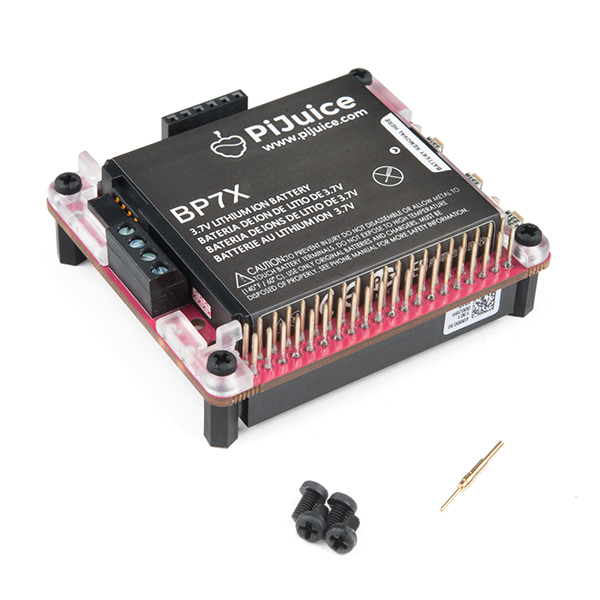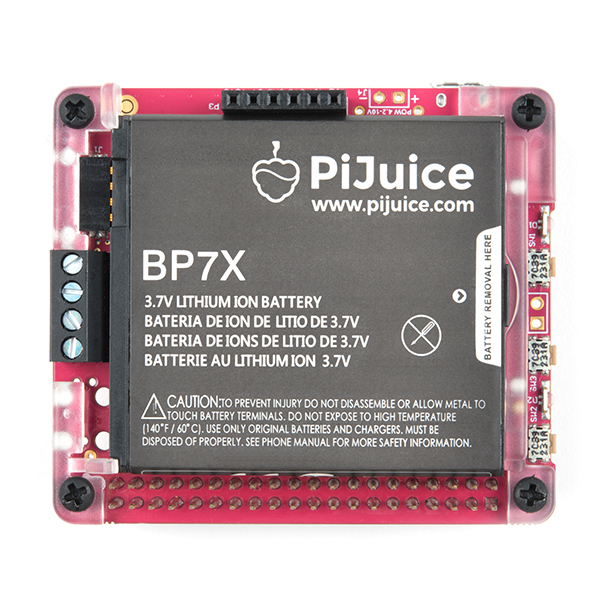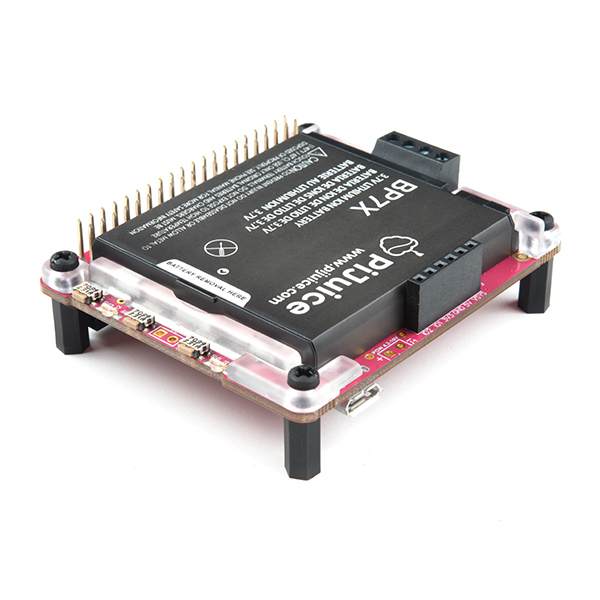As one of the smallest systems around there are so many amazing things you could do with the Raspberry Pi if it was self-powered and portable. That's exactly where the PiJuice comes it! A fully uninterruptible power supply HAT that will always keep your Raspberry Pi powered.
The revolutionary PiAnywhere technology contained in every PiJuice HAT - is the best way to take your Pi off the grid! The on board real time clock (RTC) will let your Pi know what time it is even with no power input or internet connection. Alongside this is an integrated microcontroller (MCU) chip which will manage soft shut down functionality and a true low power deep sleep state and intelligent startup.
You will be able to always keep track of the charge levels and other info with the two built-in RGB LEDs, trigger events and scripts with the three programmable buttons and since the PiJuice will use up to just five of your GPIO pins (just power and I2C), the rest are free to diversify your project. The stacking header allows you to continue to use your existing HATs and add-ons with the PiJuice.
Note: In the instructions, it specifies to attach a pogo pin for the wake function, but it doesn't line up with the Raspberry Pi 3B+. You can add a bodge wire for the functionality of the pin; however, the manufacturer recommends plugging in the power to the PiJuice directly, bypassing the need for the pogo pin.
- 1x PiJuice HAT
- 1x BP7X 1820mAh Battery
- 1x PiJuice Guide
- 4x Mounting posts attached to PiJuice
- 8x Mounting screws (4 are already assembled to the board)
- 1x Pogo pin
- 3x Stickers
- On board 1820mAh Lipo / LiIon battery for ~4 to 6 hours in constant use! (with support for larger Lipo Battery of 5000 or 10,000 mAH+ to last up to 24 hrs +)
- Designed for the Raspberry Pi A+, B+, 2B, 3B and 3B+ but also compatible with Raspberry Pi Zero v1.3 and Raspberry Pi Zero Wireless.
- Input voltage range: 4.2V 10V
- Output voltage: 3.3V and 5V
- Integrated Real Time Clock
- Onboard intelligent on/off switch
- Low power deep-sleep state with wake on interrupt/calendar event
- Programmable multi-colored RGB led (x2) and buttons (x3) with super simple user-configurable options
- Hardware watchdog timer to keep your Raspberry Pi on and working in mission-critical remote applications
- Full power management API available to Raspberry Pi OS with auto shutdown capability when running low on batteries
- Enhanced graphical user interface (GUI) available for easy install (via APT)
- Customizable scripts for enhanced flexibility and full report of battery status
- All GPIOs available via stackable header for ease of expandability and connectivity
- Charge via on-board micro USB or via the Raspberry Pi micro USB (or from onboard pin headers)
- Batteries can be charged from different type of sources and voltages
- Replace the battery without downtime. Compatible with any single cell LiPo or LiIon battery
PiJuice HAT - Raspberry Pi Portable Power Platform Product Help and Resources
Pi Wedge
Not directly compatible with the Pi Wedge, the battery pack is too close to the headers for the notch on the ribbon cable that is used.
Pogo Pin for Raspberry Pi 3B+
In the instructions, it specifies to attach a pogo pin for the wake function, but it doesn't line up with the new Raspberry Pi 3B+. You can add a bodge wire for the functionality of the pin; however, the manufacturer recommends plugging in the power to the PiJuice directly, bypassing the need for the pogo pin.
Core Skill: DIY
Whether it's for assembling a kit, hacking an enclosure, or creating your own parts; the DIY skill is all about knowing how to use tools and the techniques associated with them.
Skill Level: Rookie - Basic hand tools are required and instructions will allow more freedom. You may need to make your own decisions on design. If sewing is required, it will be free-form.
See all skill levels
Core Skill: Programming
If a board needs code or communicates somehow, you're going to need to know how to program or interface with it. The programming skill is all about communication and code.
Skill Level: Competent - The toolchain for programming is a bit more complex and will examples may not be explicitly provided for you. You will be required to have a fundamental knowledge of programming and be required to provide your own code. You may need to modify existing libraries or code to work with your specific hardware. Sensor and hardware interfaces will be SPI or I2C.
See all skill levels
Core Skill: Electrical Prototyping
If it requires power, you need to know how much, what all the pins do, and how to hook it up. You may need to reference datasheets, schematics, and know the ins and outs of electronics.
Skill Level: Competent - You will be required to reference a datasheet or schematic to know how to use a component. Your knowledge of a datasheet will only require basic features like power requirements, pinouts, or communications type. Also, you may need a power supply that?s greater than 12V or more than 1A worth of current.
See all skill levels
Comments
Looking for answers to technical questions?
We welcome your comments and suggestions below. However, if you are looking for solutions to technical questions please see our Technical Assistance page.
Customer Reviews
3.2 out of 5
Based on 5 ratings:
3 of 3 found this helpful:
Glitchy, unreliable, pseudo-open source toy
Buttons on the device are hard to press and unreliable. Terrible documentation that reads more like a sales pitch than actual help. Wake up requires a pogo pin that basically marries the hat to the particular model of Pi you can use with it, and it's not very well marked on the board where (and how) to set it.
Command line interface is just a text based GUI instead of just letting you dispatch shutdown/power off commands, or read battery charge remaining. This severely limits the utility of the device unless you want to break out a Python script (The calls are supposed to be already done to support the GUI, so why do users have to reinvent the wheel?). It doesn't log keypresses or power events.
It looks open source, but look closely. From the Github: "The firmware source code is not intended to be made openly available as it requires deep understanding of the hardware design and the programming involved if you wanted to customise it."
My project needs some flexible power management and a COTS hat to make this happen sounded very attractive considering the work involved, but I basically wasted my money and will have to build something more useful instead.
But, hey, it's got an RGB LED on it. :/
1 of 1 found this helpful:
The PiJuice Hat works as advertised
It took me a while to test it and make sure I could use it in my application, but I am completely satisfied with the PiJuice. I would recommend it without restriction.
3 of 4 found this helpful:
Good for some purposes, but not perfect
I bought this hoping that I sould use it with a Zero V 1.3 (not a W!) to do some presentations (demonstrating that a $5 computer is a serious computer). First minor problem is that I had to remove (unscrew) on of the standoffs to get access to the Zero's HDMI connector -- not a biggie, but could have been mentioned in the documentation.
More significant is that it goes from 97% capacity (never does reach 100% capacity) to down in the 40's in about half an hour, so I can't use it to provide all the power for a roughly 1 hour presentation. (I have a Ethernet/USB Hub, and a "generic" USB mouse and keyboard, attached as well.) Not sure if buying a new BP7X locally would improve it enough to be worthwhile.
Even more significant is that, in my humble opinion, it's FAR too easy to accidentally hit the "ON" button. I might be able to rig some sort of protector for the button, but this is a serious problem. Taking out the battery pack would cause the RTC to lose the time & date, which would also be a problem.
It's also annoying to have LEDs flash at all when the unit is turned off and not attached to an external power supply. (I can just picture the raised eyebrows of a TSA agent...) I'll have to remember to turn off the LEDs (in software) before air travel, then use the aforementioned Ethernet connection to log into it at the other end and re-enable the charge indicators. (I'd suggest a "firmware" enhancement - if the Pi is turned off, and no external power is connected, turn OFF the LEDs, but if one of the other buttons is pressed, show an indication of charge for 1 second.)
This unit has some interesting and useful features, but does have a few problems as well.
0 of 2 found this helpful:
Best Product
It best product.
Didn't work so well for me
Easy to set up, provided power well, but not long. Battery dies in less than an hour, but there are good tutorials on how to add a bigger battery. But the worst problem by far is that for some reason it blocks the WIFI. I can connect about 10% of the time, then the wifi just cuts out. WIFI works fine on the Pi without it... consistently not with it.







Three things I find a bit disappointing (pre-purchase): First is that there doesn't seem to be a schematic readily available. Second is that the documentation I've been through so far doesn't mention what I2C address(es) are used by the module. Third is that the RTC (I assume that it's actually a Real Time Clock Calendar, or RTCC, and provided by the ST Micro STM32F030CCT6 - again, I haven't had time to read the datasheet for that part) is apparently powered by the rechargable battery rather than by a separate "coin cell", which means that if the rechargable battery gets too low the time will be lost, and/or the RTC can conceivably run the rechargable battery down to the point where the battery gets damaged/destroyed.
The first two are things that the folks at PiJuice and/or SparkFun could (easily) do something about, and the third probably needs to (a) include mention of in the documentation (something like "if you're not going to use your PiJuice for several months, remove the battery to prevent damage") and (b) go on the list of things for the "next revision".
Oh, one other thing: I'd really like to see the overall dimensions listed (yeah, I know, there's a picture with rulers, but it doesn't show the total height!) and the WEIGHT (or technically mass, if you want to post it in grams). (For this one, I'd take a moment to weigh it both with and without the battery installed, as it can use external batteries.)
The schematic is available on the GitHub page:
https://github.com/PiSupply/PiJuice/raw/master/Documentation/PiJuice_Schematic.PDF
Thanks for the pointer!
I don't have time at the moment to read the datasheet for the STM32P030CCT6, but based on my experience VDDA likely supplies the RTC. If that's so, I suspect that a little bit of "surgery" (removing FB3 and bringing the VDDA out to a separate battery) could solve the problem by allowing the LiPo to be removed entirely (and thus not be subject to over-discharge by the parts of the circuit that are continuously powered up) while still allowing the RTC to continue running.
The I2C addresses for both the PiJuice and the RTC are user configurable. I have not done it, but the instructions are available on GitHub, along with comprehensive questions and answered.
https://uk.pi-supply.com/products/pijuice-standard
Boxed weight - 96g Boxed dimensions - 12.2 x 10.8 x 3.5 cm Unboxed weight - 57g Unboxed dimensions - 6.5 x 5.6 x 2 cm
Thank you!
Is it possible to purchase this without the battery? I am overseas and battery shipments are a nightmare. I can get the battery locally so I would only need the board.
Unfortunately we can't, but the part is listed with a "battery contained in part"... so I believe it should be fine if shipped internationally.
Hypothetically, would I be able to wake up the PI if a power input through the charging port Suddenly became active?
Not just hypothetically, but actually!